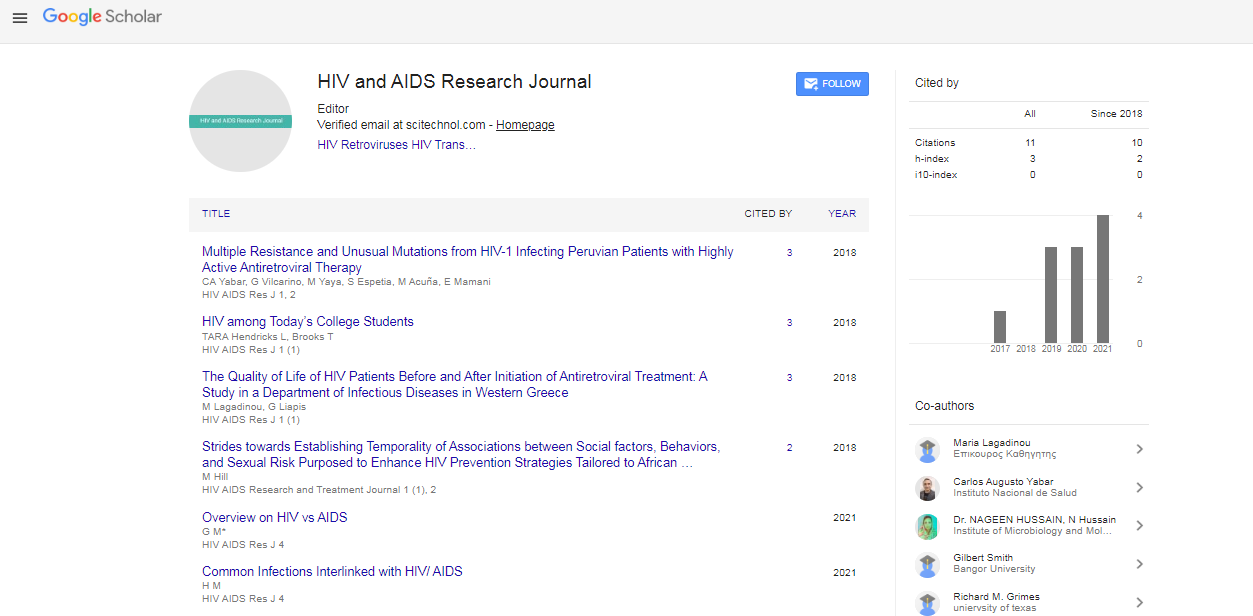Perspective, Hiv Aids Res J Vol: 6 Issue: 2
Antiretroviral Therapies: Preventing HIV Retrovirus Effects and Transmission
Takema Shikako*
1Department of Laboratory Medicine, Tokyo Medical University, Tokyo, Japan
*Corresponding Author: Takema Shikako,
Department of Laboratory Medicine,
Tokyo Medical University, Tokyo, Japan
E-mail: takema_shikako@tmu.jp
Received date: 23 August, 2023, Manuscript No. HARJ-23-118050;
Editor assigned date: 25 August, 2023, PreQC No. HARJ-23-118050 (PQ);
Reviewed date: 08 September, 2023, QC No. HARJ-23-118050;
Revised date: 15 September, 2023, Manuscript No. HARJ-23-118050 (R);
Published date: 22 September, 2023, DOI: 10.4172/Harj.1000126
Citation: Shikako T (2023) Antiretroviral Therapies: Preventing HIV Retrovirus Effects and Transmission. HIV AIDS Res J 6:2.
Description
The Human Immunodeficiency Virus (HIV) has been one of the most challenging global health crises of time. Since the beginning of the epidemic, HIV has infected over 75 million people and claimed the lives of nearly 32 million. However, Anti-Retroviral Therapies (ART) have played a major role in the enormous advances made in the management of this infection. HIV is a retrovirus that primarily attacks the immune system, specifically CD4+ T cells. Once inside the body, it replicates and gradually weakens the immune system, making the infected individual susceptible to opportunistic infections and certain cancers. Without intervention, HIV infection can progress to Acquired Immunodeficiency Syndrome (AIDS), a condition where the immune system is severely compromised.
The primary mode of HIV transmission is through physical contact, sharing needles for drug use, or from mother to child during childbirth or breastfeeding. To reduce transmission rates, several prevention strategies have been implemented, with ART being an essential component. ART has been shown to dramatically reduce the amount of virus in the blood, often to undetectable levels. This not only benefits the health of the individual but also drastically reduces the risk of HIV transmission to sexual partners. When the viral load is undetectable, the chance of transmitting the virus is effectively zero, a concept known as U=U (Undetectable=Untransmittable).
Pre-Exposure Prophylaxis (PrEP) involves the use of ART medications by individuals who are at high risk of HIV infection. Taking PrEP daily significantly reduces the likelihood of acquiring the virus, especially in individuals engaged in high-risk behaviours. ART doesn't only play an essential role in reducing transmission; it is also vital for managing the effects of the virus on those who are already infected. ART helps maintain or even restore immune function by reducing the viral load. This allows the immune system to recover, making the individual less susceptible to infections and diseases.
Early initiation of ART, as recommended by current guidelines, can slow the progression of HIV infection to AIDS. This means individuals can live longer, healthier lives. ART significantly lowers the risk of opportunistic infections, such as tuberculosis and certain cancers, which are common in individuals with untreated HIV. ART not only prolongs life but also improves the quality of life for people living with HIV. It reduces the symptoms of the disease, allows for normal daily activities, and minimises hospitalisations.
While ART is an important tool to fight against HIV, ensuring access to ART for all who need it, especially in resource-limited settings, remains a significant challenge. Barriers can include cost, healthcare infrastructure, and stigmatisation. ART requires strict adherence to medication regimens, which can be challenging for some individuals. Missed doses can lead to treatment failure and the development of drug-resistant strains of the virus. ART can have side effects ranging from mild to severe. These side effects can affect an individual's adherence to treatment. Stigma around HIV still exists in many societies. This can deter individuals from seeking testing, treatment, or disclosing their status.
Conclusion
Antiretroviral Therapies are a remarkable advancement in the battle against HIV retroviruses. They play a key role in preventing transmission and managing the effects of the virus on infected individuals. As one can move forward, it is essential to address the barriers to ART access, promote adherence, and reduce stigma and discrimination to maximize the potential of these life-saving medications. With continued studies, investment, and global cooperation, one can strive for a world where HIV is no longer a global health crisis.
 Spanish
Spanish  Chinese
Chinese  Russian
Russian  German
German  French
French  Japanese
Japanese  Portuguese
Portuguese  Hindi
Hindi 